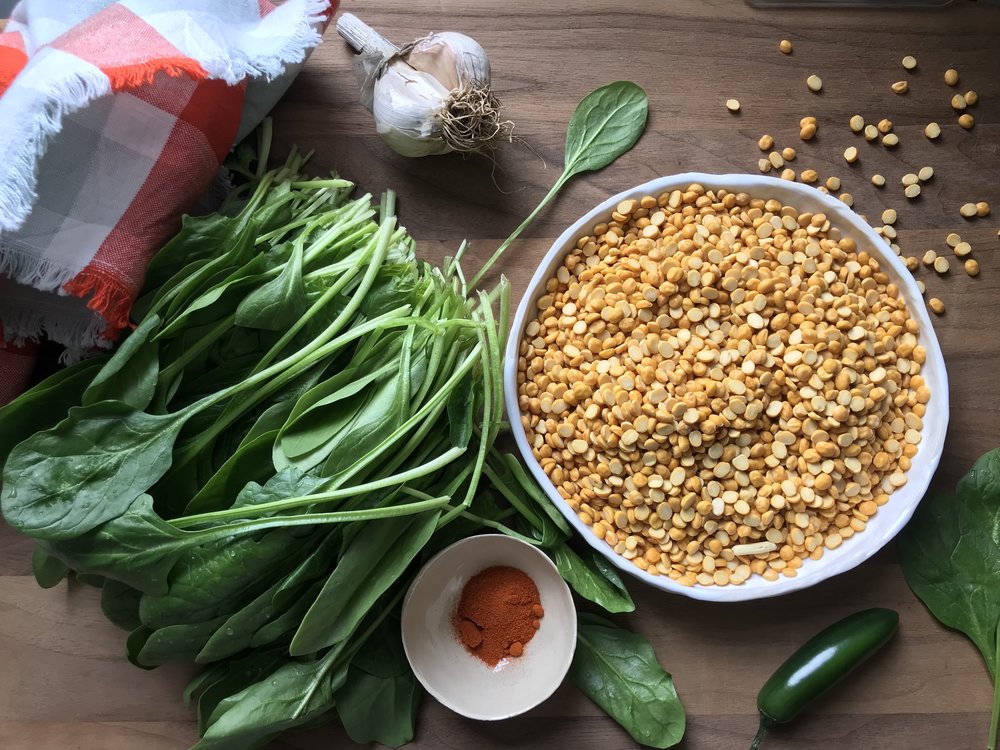Indian Dal from Anitha Baliga

When Anitha Baliga thinks of comfort food, it’s not meatloaf or chicken pot pie. It’s dal, the staple she grew up with in her small town along the southern coast of India.
A traditional Indian lentil dish, dal is prepared in a variety of ways, depending on what region its maker is from and what type of legume is being used. As a young girl, Anitha’s mother, a champion of sustainability and efficiency, insisted on preparing a small amount of fresh food daily and made sure a fresh pot of dal and rice arrived promptly at Anitha’s primary school at lunchtime. Sure beats a bologna sandwich!
When Anitha came over to show me how she prepares dal, I was given fair warning that her spicy dish resembles the north Indian Punjabi style, which she learned to prepare while living in Mumbai.
“What you’ll eat is nothing like my mother’s dal from the southern coast of the country or other types of dal. Everyone has her own way of making the dish,” she said.
Anitha’s jam-packed schedule has forced her to adapt the dish to her busy lifestyle. She cooks it in a pressure cooker so it’s done in 20 minutes. Next she adds spinach, tomatoes and onions to the lentils to give the dish more color and to make for a complete vegetarian meal.
Toordal, or yellow pigeon peas, are one of many basic quality legumes one can use to make this dal, but it’s essential to use the most authentic and fresh ingredients and spices you can find.
The ground cumin that’s been sitting in your cabinet for six years is not gonna cut it.
Ginger, garlic, green chili peppers, cilantro, cumin seeds and the pungent, fragrant asafoetida powder are the core ingredients you’ll need.
Going to an Indian market will make all the difference. The quality of long grain Basmati rice and spices as well as the variety of lentils far surpass anything you’ll get your hands on in a regular specialty foods store or supermarket. Go for a walk along Lexington Avenue in the 20s or head out to Jackson Heights, Queens for access to authentic products.
*This article was originally written and published in The Riverdale Press in April, 2011.
Serving Size: 6-8
Ingredients
3 Cups toordal (yellow pigeon pea lentils), soaked in cold water for 5 hours
6 to 7 garlic cloves, chopped
2 Tbsps. ginger, minced
2 to 3 Indian chiles or serrano peppers, split
1 medium yellow onion, sliced in half from root to stem, then sliced crosswise thinly
5 ozs. baby spinach, prewashed
2 Tbsps. unsalted butter
2 Tbsps. vegetable oil
1 Tbsp. cumin seeds (whole)
1/2 Tbsp. turmeric powder
1/4 tsp. asafoetida
1/4 tsp. red pepper flakes or pinch of cayenne pepper
1 small onion, chopped
2 plum or roma tomatoes, chopped
1 bunch picked cilantro leaves (about 2 Cups loosely packed)
Salt and pepper, as needed
basmati rice, for serving
Instructions
Rinse the lentils 4 to 5 times with fresh changes of cold water.
Place the lentils in a large pot with 9 Cups of cold water. Bring to a simmer and cook for 30 to 35 minutes, skimming any impurities from the surface of the liquid.
Add the garlic, ginger, chilis, and onion and cook another 30 minutes, stirring occasionally so that lentils don’t stick to the bottom of the pot.
Begin to mash the lentils with the back of a large spoon. Continue to cook until falling apart slightly, about 30 more minutes. They should be tender without turning to mush.
Remove the chilis. Add spinach and season with salt.
In a separate skillet, melt the butter and oil. Add the cumin and toast for about 30 seconds until brown and golden. Add the turmeric, asafoetida powder and red pepper flakes and cook another 20 to 30 seconds.* The mixture should be golden and very aromatic.
Add the onions and cook over medium high heat until they start to color. Add the tomatoes and continue to sauté until the onion and tomato mixture is slightly glossy, about 2 minutes.
Transfer the tomato/onion mixture along with the fresh cilantro leaves to the lentils and stir well to incorporate. Taste for seasoning and adjust with salt and pepper to taste.
Serve immediately with cooked basmati rice.
Cook's Notes
Toasting the spices sufficiently before adding to the lentils is an important step in making the dal and seasoning it correctly. Toasting maximizes the spices’ flavors and removes some of the rawness and pungency they have prior to cooking so be sure not to skip this step and just sprinkle your spices into the lentils.
